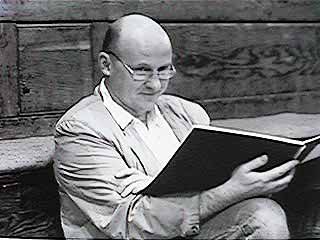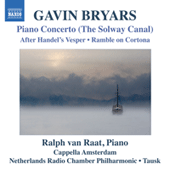"There's another way of making music ..."
"... by touching the lives and feelings of ordinary people.” This quote from Gavin Bryars points to his mission as a composer, and is revealed through some of his new music for piano.
 via www.gavinbryars.comYou won’t find much in Gavin Bryars’ new Piano Concerto that is harsh to the ears. The stereotypical avant-garde music of the 20th and 21st Centuries is far removed from the music on the new Naxos release of Bryars’ Piano Concerto (The Solway Canal), After Handel’s Vespers and Ramble on Cortona.
via www.gavinbryars.comYou won’t find much in Gavin Bryars’ new Piano Concerto that is harsh to the ears. The stereotypical avant-garde music of the 20th and 21st Centuries is far removed from the music on the new Naxos release of Bryars’ Piano Concerto (The Solway Canal), After Handel’s Vespers and Ramble on Cortona.
The British composer is perhaps best known for his pieces The Sinking of the Titanic and Jesus Blood Never Failed Me Yet. Both were written for atypical ensembles, including tape and other electronics, and were first recorded on Brian Eno’s record label in the 1970s. (They have since been revised and rerecorded). It’s telling that his early music was released on Eno’s record label; it’s not ambient music, but Bryars’ music has a familial relationship with it. Bryars’ was a student of John Cage and his compositions place him near the better known Gorecki and Pärt on the musical family tree. Here, Bryars looks to more traditional ensembles and forms on one of the finer classical music releases of the first part of 2011.
 via www.naxos.comThe Piano Concerto is not one that features technical flair and drama. An audience won’t instinctively leap to its feet as they would at the end of a Rachmaninov concerto. But that doesn’t make it any less intriguing or enjoyable. What you’ll hear, instead, is a nearly 30-minute piece for piano, men’s chorus and orchestra that borders between impressionistic and post-minimalist styles, full of dark, evocative sounds and subtlety. The piano serves as a mentor to the ensemble, guiding and handing off material to the orchestra, rather than forcing them to serve a more subservient role as in more traditional concerti.
via www.naxos.comThe Piano Concerto is not one that features technical flair and drama. An audience won’t instinctively leap to its feet as they would at the end of a Rachmaninov concerto. But that doesn’t make it any less intriguing or enjoyable. What you’ll hear, instead, is a nearly 30-minute piece for piano, men’s chorus and orchestra that borders between impressionistic and post-minimalist styles, full of dark, evocative sounds and subtlety. The piano serves as a mentor to the ensemble, guiding and handing off material to the orchestra, rather than forcing them to serve a more subservient role as in more traditional concerti.
The piece opens simply enough, with open 5ths played by the orchestra and piano, but soon the tonal center shifts around, never quite leaving A minor and C major, but never quite settling on it, either. Chromaticism recurs through the piece, often on the outlying edges of the score, but never intrudes enough for the piece to lose its tonal feel. The imagery of the sonnets by Scottish poet Edwin Morgan and the haunting quality of the men’s chorus are unusual in the context of a piano concerto, but suit this piece and Bryars’ compositional style well. This is an unobtrusive piece, whose beauty lies in its simplicity. It’s the first glimpse of a flower bud underneath the snow of a long winter.
The opening pieces on the album are for solo piano. After Handel’s Vespers was originally written for the harpsichord, and translates well to the piano. Ramble on Cortona is Bryars’ first work for solo piano, the dedicatee, like the Piano Concerto, being pianist van Raat. Both works acknowledge earlier music – Vespers from the 17th and 18th Centuries, Ramble from the 13th Century – but take full advantage of the piano’s sonorities and the capabilities of a contemporary composer. As Bryars has said, “one of the challenges I enjoy is writing in the light of history … I take great sustenance from the music of the past.” He has the ability to reference and incorporate earlier styles without losing his own voice.
The performances by piano soloist Ralph van Raat, the Netherlands Radio Chamber Philharmonic and the men of the Capella Amsterdam suit the music well. Raat has a touch that brings out the lyrical qualities of Bryars’ music, and the Philharmonic lingers on every note in the Piano Concerto until the last possible minute, absorbing themselves and the listener in the moments at hand.
Kudos to Naxos for this fine album, and for continuing to release new music. The label has long moved from simply being a clearinghouse of “budget classical” records made by Eastern European musicians to one of the foremost record labels for new and previously unrecorded classical music.